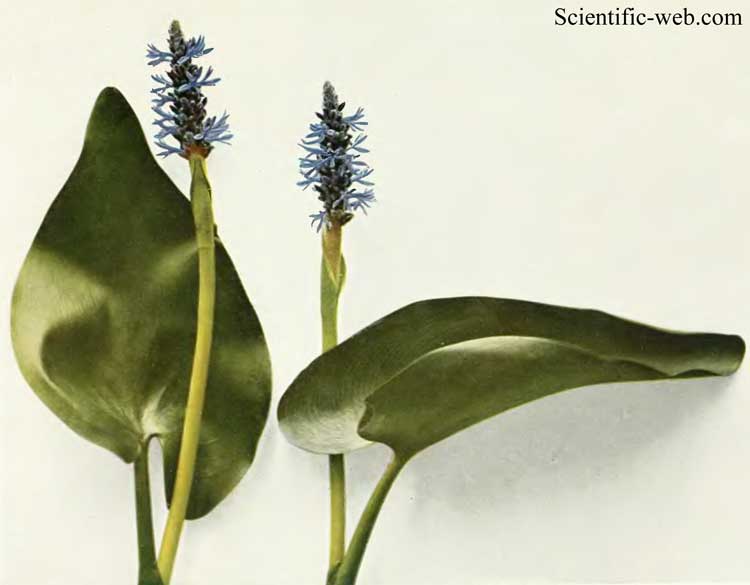
Pontederia cordata
Classification System: APG IV
Superregnum: Eukaryota
Regnum: Plantae
Cladus: Angiosperms
Cladus: Monocots
Cladus: Commelinids
Ordo: Commelinaless
Familia: Pontederiaceae
Genus: Pontederia
Species: Pontederia cordata
Varietas: P. c. var. cordata – P. c. var. ovalis
Name
Pontederia cordata L. (1753)
Synonyms
Homotypic
Narukila cordata (L.) Nieuw., Amer. Midl. Naturalist 3: 101 (1913).
Pontederia cordata var. typica Solms, Monogr. 4: 532 (1883), nom. inadmiss., p.p.
Umsema mucronata Raf., Med. Repos., ser. 2. 5: 352 (1808), [[nom. illeg.]]
Umsema obtusifolia Raf., Med. Repos., ser. 2. 5: 352 (1808), Med. Repos. 5: 350 (1819), nom. illeg
Unisema cordata (L.) Farw., Pap. Michigan Acad. Sci. 3: 92 (1924).
References
Linnaeus, C. 1753. Species Plantarum. Tomus I: 208. Reference page.
eFloras 2008. Pontederia cordata in Flora of North America . Missouri Botanical Garden, St. Louis, MO & Harvard University Herbaria, Cambridge, MA.
Vernacular names
Deutsch: Herzblättrige Hechtkraut
English: Pickerelweed
suomi: Herttasoikko
français: Pontédérie à feuilles en cœur
íslenska: Hjartagoði
Nederlands: Moerashyacint
Pontederia cordata, common name pickerelweed (USA) or pickerel weed (UK), is a monocotyledonous aquatic plant native to the American continents. It grows in a variety of wetlands, including pond and lake margins across an extremely large range from eastern Canada south to Argentina. A few examples include northern rivers,[3] the Everglades[4] and Louisiana.[5]
Ecology
The species grows as an emergent plant, that is, in flooded conditions, so the plant is generally dependent upon aerenchyma in the stem to carry oxygen into the roots. Its metabolism, is, however, also tolerant of low soil oxygen.[6] It is often found in areas where water levels fluctuate naturally, with spring flooding and later summer emergence. Apart from flooding, the species is also influenced by soil fertility, tending to grow in the more fertile bays of large lakes, for example. Like many aquatic plants, it is negatively affected by salinity and grazing.[7] It is also negatively affected by competition from other wetland plants.[8] Like many wetland plants, it can survive unfavorable conditions as buried seeds in the soil.[9]
Flowers
The plant flowers in late summer. The purple flowers have yellow markings which may assist in attracting bees for pollination.[10] Two species known to pollinate the flowers are Melissodes apicatus and Dufourea novaeangliae.[11][12] Once the plant begins to produce seeds, the stem supporting the inflorescence bends to submerge the fruits and seeds.[7] Seeds are dormant at the time of dispersal and will not germinate without stratification for 6–8 weeks.[9]
The flowers of the species are tristylous, meaning the styles of individual plants occur in three different morphs, with most populations containing all three. Leaf shape, which varies considerably across populations, within populations, and even within individuals, has been the source for many taxonomic synonyms.[13] Like many wetland and aquatic plants, the species can reproduce asexually by means of branching rhizomes, and hence can form large clonal stands.[11]
Pickerelweed near Ottawa, Ontario
Cultivation
This plant is cultivated as an ornamental garden pond plant, and has gained the Royal Horticultural Society's Award of Garden Merit.[14][15]
Uses
The young leafstalks can be eaten raw (with the unripe fruits stripped off) or cooked. The seeds are edible raw, and can be ground into grain.[16][17]
References
NatureServe (2006), "Pontederia cordata", NatureServe Explorer: An online encyclopedia of life, Version 6.1., Arlington, Virginia, retrieved 2010-07-25
"Pontederia cordata (Pickerelweed, Pickerel Weed)". North Carolina Extension Gardener Plant Toolbox. NC State University. Retrieved 2020-01-14.
Day, R. T., Keddy, P. A., McNeill, J., and Carleton, T. (1988). Fertility and disturbance gradients: a summary model for riverine marsh vegetation. Ecology, 69, 1044–54.
Loveless, C. M. (1959). A study of the vegetation in the Florida everglades. Ecology, 40, 1–9.
Keddy, P. A., Campbell, D., McFalls T., Shaffer, G., Moreau, R., Dranguet, C., and Heleniak, R. (2007). The wetlands of lakes Pontchartrain and Maurepas: past, present and future. Environmental Reviews, 15, 1–35.
Laing, H. E. (1940). Respiration of the rhizomes of Nuphar advenum and other water plants. American Journal of Botany, 27, 574–81.
Keddy, P.A. 2010. Wetland Ecology: Principles and Conservation (2nd edition). Cambridge University Press, Cambridge, UK. 497 p
Geho, E. M., Campbell, D., and Keddy, P. A. (2007). Quantifying ecological filters: the relative impact of herbivory, neighbours, and sediment on an oligohaline marsh. Oikos, 116, 1006–16.
Whigham, Dennis F. and Robert L. Simpson. 1982. Germination and dormancy studies of Pontederia cordata L. Bulletin of the Torrey Botanical Club 109: 524–528.
Sculthorpe, C. D. (1967). The Biology of Aquatic Vascular Plants. Reprinted 1985 Edward Arnold, by London. p. 280.
Hutchinson, G. E. (1975). A Treatise on Limnology, Vol. 3, Limnological Botany. New York: John Wiley. p.229.
Mitchell, T. B. (1962). Bees of the Eastern United States. North Carolina Agricultural Experiment Station Technical Bulletin 152(2): 1–557.
Adanson, Narukila; Rafinesque, Umsema; Rafinesque, Unisema (2002), "Pontederia cordata", in Flora of North America Editorial Committee, eds. 1993+ (ed.), Flora of North America, vol. 26, New York & Oxford: Oxford University Press, p. 45
"RHS Plant Selector – Pontederia cordata". Retrieved 6 February 2021.
"AGM Plants – Ornamental" (PDF). Royal Horticultural Society. July 2017. p. 81. Retrieved 12 May 2018.
Niering, William A.; Olmstead, Nancy C. (1985) [1979]. The Audubon Society Field Guide to North American Wildflowers, Eastern Region. Knopf. p. 711. ISBN 0-394-50432-1.
Elias, Thomas S.; Dykeman, Peter A. (2009) [1982]. Edible Wild Plants: A North American Field Guide to Over 200 Natural Foods. New York: Sterling. p. 130. ISBN 978-1-4027-6715-9. OCLC 244766414.
Retrieved from "http://en.wikipedia.org/"
All text is available under the terms of the GNU Free Documentation License

